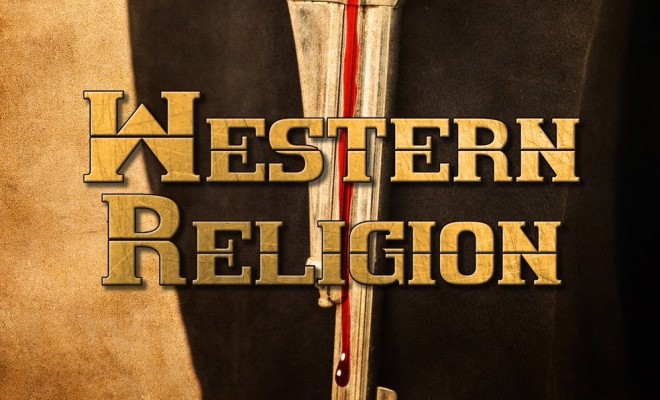
James O’Brien’s Western Religion
“The year is 1879. Gunfighters and cardsharps from the far reaches of the globe descend on the mining town of Religion, Arizona to compete in a legendary poker tournament. Drawn to town by the gold prize, the players come to realize that in this game their very souls are at stake.”
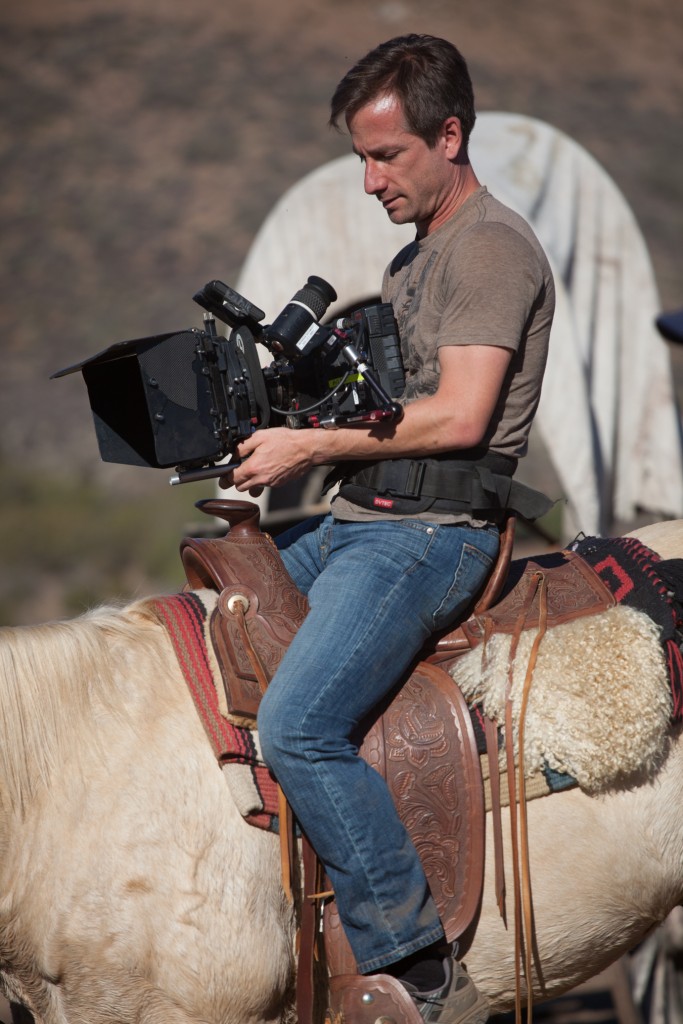 Thus begins a tale weaving together a cast so diverse it includes an Arabian Prince and a Morphine addict from Vienna. Shot with a minimum budget and with the loss of their intended filming location, the fact that this film could be cobbled together is nearly miraculous – something Gary Douglas Kohn’s character Saint John might have been relied upon to provide. But in the end, it would seem what were at first seen as set backs aided to provide this unexpected film with just the right ingredients needed to make Western Religion one of those under-the-radar masterpieces. There’s no mistaking this film within the western genre or in the greater world of Indie films. It is one of those films whose genius you might miss upon casual viewing but later, when returning to the film realize the subtle way in which the story penned by James O’Brien plays out. But of course even the most skilled screen writers may never see their genius come to the big screen if it weren’t for the talented actors who speak their lines. Here again O’Brien’s skill at producing a film comes to the rescue. He has cast a crew of creative talent to carry the story along and at some point we forget we are sitting in a theater or at home and find ourselves amidst a crowd of prospectors seeking their fortunes in a dusty tent.
Thus begins a tale weaving together a cast so diverse it includes an Arabian Prince and a Morphine addict from Vienna. Shot with a minimum budget and with the loss of their intended filming location, the fact that this film could be cobbled together is nearly miraculous – something Gary Douglas Kohn’s character Saint John might have been relied upon to provide. But in the end, it would seem what were at first seen as set backs aided to provide this unexpected film with just the right ingredients needed to make Western Religion one of those under-the-radar masterpieces. There’s no mistaking this film within the western genre or in the greater world of Indie films. It is one of those films whose genius you might miss upon casual viewing but later, when returning to the film realize the subtle way in which the story penned by James O’Brien plays out. But of course even the most skilled screen writers may never see their genius come to the big screen if it weren’t for the talented actors who speak their lines. Here again O’Brien’s skill at producing a film comes to the rescue. He has cast a crew of creative talent to carry the story along and at some point we forget we are sitting in a theater or at home and find ourselves amidst a crowd of prospectors seeking their fortunes in a dusty tent.
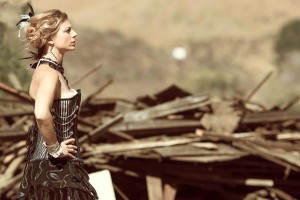 One of the most important characters in the film – the character foiled by Kohn’s Saint John was not cast until the final weeks before filming. That is of course Claude Duhamel, brought on board to play Anton Stice, a character who may have been stolen from a passage in Revelation regarding the appearance of evil in the landscape. Its as though one of the horsemen of the Apocalypse has arrived in Religion and upon dismounting his horse irrevocably altered the course of the winner-take-all tournament. The forces of good and evil loom in the background as each character must face their inner demons while a winner is determined in a poker game at the edge of civilization. It is not until the final climactic moments of the film that we learn the true nature of this competition and the fate of the small tent city called Religion.
One of the most important characters in the film – the character foiled by Kohn’s Saint John was not cast until the final weeks before filming. That is of course Claude Duhamel, brought on board to play Anton Stice, a character who may have been stolen from a passage in Revelation regarding the appearance of evil in the landscape. Its as though one of the horsemen of the Apocalypse has arrived in Religion and upon dismounting his horse irrevocably altered the course of the winner-take-all tournament. The forces of good and evil loom in the background as each character must face their inner demons while a winner is determined in a poker game at the edge of civilization. It is not until the final climactic moments of the film that we learn the true nature of this competition and the fate of the small tent city called Religion.
Hello James! It is so good to talk to you again!
Last time we spoke Western Religion was about to be released. Here we are a year later and you have finished your release tour. The film has been shown around the world and it is now available to the public through outlets like iTunes, Youtube and Amazon.
1. How did things go with the release? Do you feel like the film has received the attention it deserves?
Western Religion had a national theatrical release, which is quite rare for a indie of its size. Our dis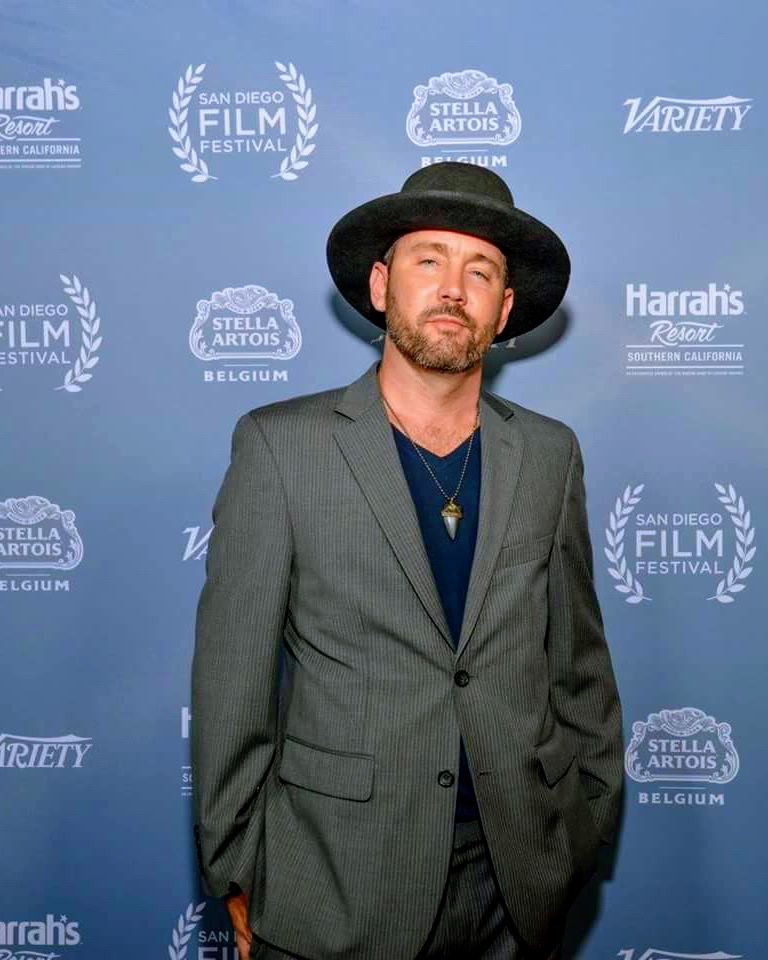 tributor Screen Media, and executives Jeremias and Sabatasso from 3rd Partner, were very pleased to see the film connect with audiences across the country, setting the stage for it’s release on VOD and DVD. There’s nothing quite like watching a movie in a darkened room with a responsive audience and I’m personally really glad the film got a chance to shine on that stage. And, of course, traveling the country in an RV with Western Religion still photographer Bill Ginkens was an unforgettable blast. Lead actors Claude Duhamel, Holiday Hadley and Sean Joyce, would fly in to meet us wherever we went and we’d bring the western circus to town. And of course, the whole cast came out for the Hollywood show. Between all the great photography Ginks took on set and in our road adventures, I expect a coffee table book will be in the works. It was a huge cast, our indie camelot, so there’s no shortage of material.
tributor Screen Media, and executives Jeremias and Sabatasso from 3rd Partner, were very pleased to see the film connect with audiences across the country, setting the stage for it’s release on VOD and DVD. There’s nothing quite like watching a movie in a darkened room with a responsive audience and I’m personally really glad the film got a chance to shine on that stage. And, of course, traveling the country in an RV with Western Religion still photographer Bill Ginkens was an unforgettable blast. Lead actors Claude Duhamel, Holiday Hadley and Sean Joyce, would fly in to meet us wherever we went and we’d bring the western circus to town. And of course, the whole cast came out for the Hollywood show. Between all the great photography Ginks took on set and in our road adventures, I expect a coffee table book will be in the works. It was a huge cast, our indie camelot, so there’s no shortage of material.
2. Can you describe your experience attending the premier of your film at Cannes?
 Western Religion premiered at the Cannes Film Festival and was subsequently invited to be one of 15 films in competition at the San Diego Film Festival. There’s a strong Native American influence in the movie and actors Sam Bearpaw and Alan Tafoya were instrumental in our involvement there. In San Diego, we connected with Sarena Cowles of Entertainment Las Vegas and NBCUniversal. She spearheaded the promotional TV coverage for our national theatrical release. We called this the “Wagon Trail Tour.” It involved red carpet interviews, horses, cowboys and Indians and, of course, good old fashioned indie promotion. It took us from the Arena Cinema in Hollywood, to the historic New Strand in Iowa, the Alamo Drafthouse in Austin, Sunshine Cinema in NYC, and finally Reel Cinema 2 in Pennsylvania, home of actor Sean Joyce, where we broke the house record on our last show, playing alongside the new Star Wars. A rare occasion for an indie to match the most successful movie franchise of all time.
Western Religion premiered at the Cannes Film Festival and was subsequently invited to be one of 15 films in competition at the San Diego Film Festival. There’s a strong Native American influence in the movie and actors Sam Bearpaw and Alan Tafoya were instrumental in our involvement there. In San Diego, we connected with Sarena Cowles of Entertainment Las Vegas and NBCUniversal. She spearheaded the promotional TV coverage for our national theatrical release. We called this the “Wagon Trail Tour.” It involved red carpet interviews, horses, cowboys and Indians and, of course, good old fashioned indie promotion. It took us from the Arena Cinema in Hollywood, to the historic New Strand in Iowa, the Alamo Drafthouse in Austin, Sunshine Cinema in NYC, and finally Reel Cinema 2 in Pennsylvania, home of actor Sean Joyce, where we broke the house record on our last show, playing alongside the new Star Wars. A rare occasion for an indie to match the most successful movie franchise of all time.
3. I was impressed with the talent you w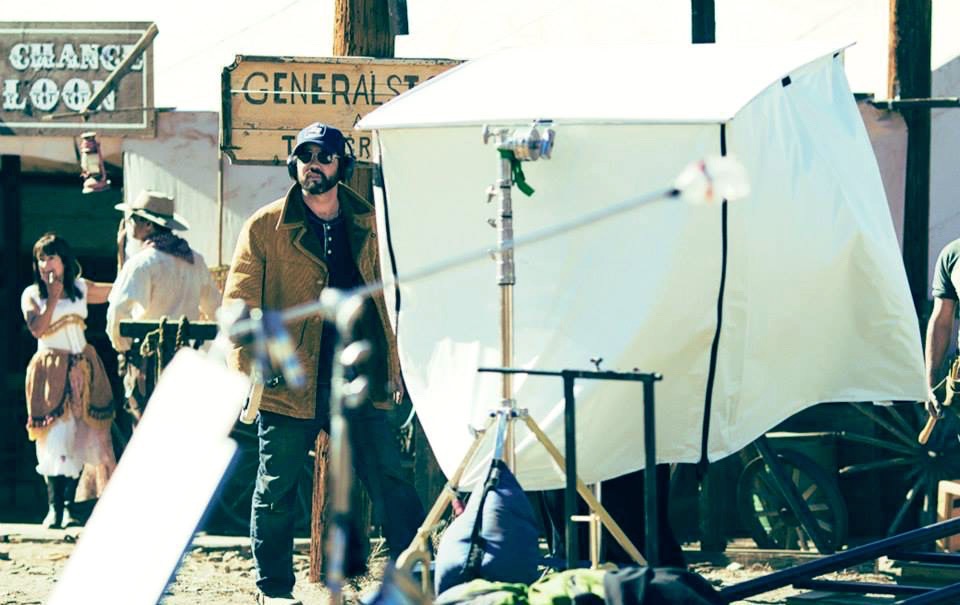 ere able to cast for the film – the acting was consistently top-notch and everyone brings a unique personality to the film. I was especially impressed with acts from Peter Sherayko as Souther Bill, James Anthony Cotton as Harvard Gold, Claude Duhamel as Anton Stice and Louie Sabatasso as Salt Peter.
ere able to cast for the film – the acting was consistently top-notch and everyone brings a unique personality to the film. I was especially impressed with acts from Peter Sherayko as Souther Bill, James Anthony Cotton as Harvard Gold, Claude Duhamel as Anton Stice and Louie Sabatasso as Salt Peter.
Can you explain how you were able to cast these roles?
The casting for Western Religion came together organically. Louie Sabatasso (Salt Peter) and Gary Kohn (Saint John) were the leads in my previous film Wish You Were Here. Gary has played a role in all of my 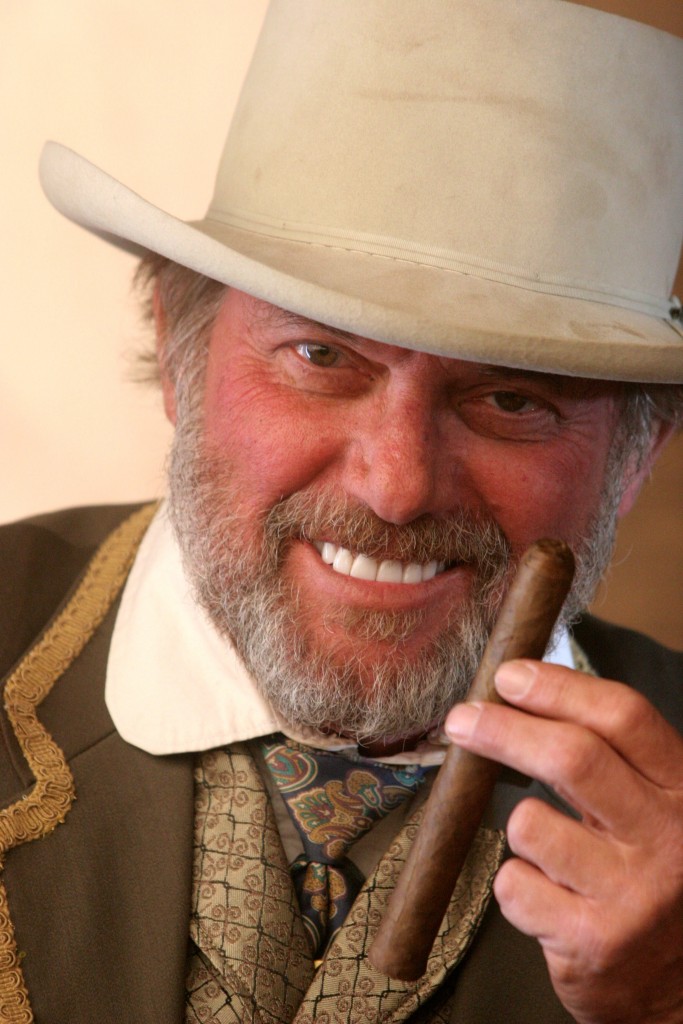 films, actually. And another longtime actor for me, Scott Donovan (Marshal Stone), who’ s also a director, set up a casting session in Hollywood, where we cast Miles Szanto (Waylin Smith) and Melissa Strom (Roberta Stone), Frankie Ray and his gang of outlaws, among many others. The big key was in casting Claude Duhamel (Anton Stice), which happened at the 11th hour. My good friend, Irish actor and filmmaker Tony Herbert, brought Peter Shinkoda (Chinaman Dan) to the table. Peter was a highly regarded talent at this point, and this is prior to his role in Marvel’s Daredevil. Shinkoda liked the script, agreed to do the role, and recommended Merik Tadros (Zain Mohammed). Both of them were friends with Claude, who got a hold of the
films, actually. And another longtime actor for me, Scott Donovan (Marshal Stone), who’ s also a director, set up a casting session in Hollywood, where we cast Miles Szanto (Waylin Smith) and Melissa Strom (Roberta Stone), Frankie Ray and his gang of outlaws, among many others. The big key was in casting Claude Duhamel (Anton Stice), which happened at the 11th hour. My good friend, Irish actor and filmmaker Tony Herbert, brought Peter Shinkoda (Chinaman Dan) to the table. Peter was a highly regarded talent at this point, and this is prior to his role in Marvel’s Daredevil. Shinkoda liked the script, agreed to do the role, and recommended Merik Tadros (Zain Mohammed). Both of them were friends with Claude, who got a hold of the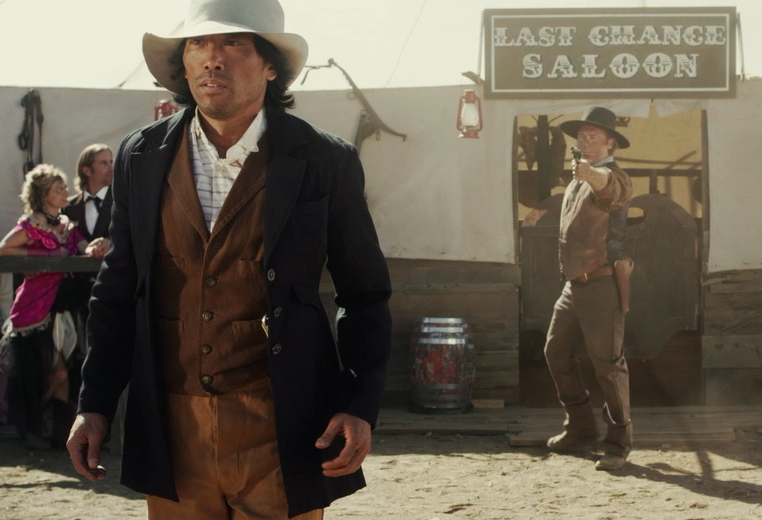 sides for Anton, the last remaining role. He sent in an audition, then came to a reading with my fellow producer, Louie Sabatasso. Louie and I agreed on the spot that we found our villain. Good thing, too, because we were less than a week from day one.
sides for Anton, the last remaining role. He sent in an audition, then came to a reading with my fellow producer, Louie Sabatasso. Louie and I agreed on the spot that we found our villain. Good thing, too, because we were less than a week from day one.
4. I thought all of the actors looked perfect in their old West costumes. Can you tell us more about putting together the wardrobe for the film?
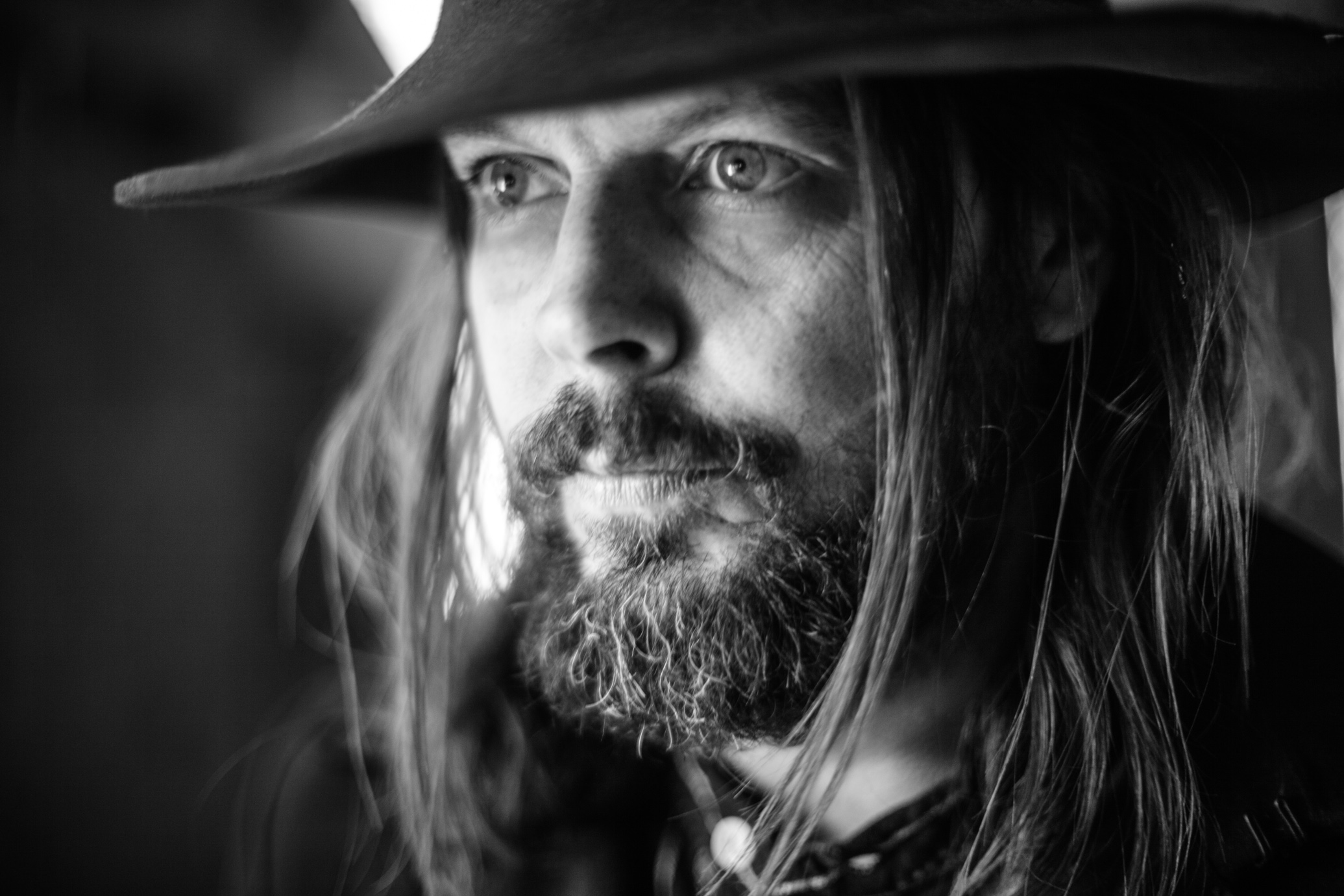 The wardrobe for the film was put together by costume designer Nikki Pelley and her assistant Alisha Needham. They were working from the extensive western collection of Peter Sherayko of Caravan West. They both did a fantastic job with our large cast of over 60 actors. And of course, much credit most go to Peter Sherayko himself. We shot the film on his land and he was the expert on period detail. Peter is a true western historian, a published author on the subject and probably the single most experienced individual in Hollywood when in comes to all things western. He played Texas Jack Vermillion in Tombstone and also provided the weapons for that show. Under the umbrella of Caravan West, we were able to bring the tent city of Religion, AZ to life from scratch. Not bad, considering we only had two weeks to do it, after the government closure of the Paramount Ranch, our initial location. It helped that Pete brought good people to the table, like designers Christian Ramirez and Zack Smith. And they worked well with our team from 3rd Partner Films. It was great to see folks like Gary Kohn and Dustin Blank, wearing a lot of hats, working on set building and then jumping in front of the camera to act as well. Fortunately, we had a great DP in Morgan Schmidt, who worked well with me and First AD Ken August, in shooting on the fly around the sets as they were being built. The illusion of making something “real” of out of something that isn’t even there is half the fun.
The wardrobe for the film was put together by costume designer Nikki Pelley and her assistant Alisha Needham. They were working from the extensive western collection of Peter Sherayko of Caravan West. They both did a fantastic job with our large cast of over 60 actors. And of course, much credit most go to Peter Sherayko himself. We shot the film on his land and he was the expert on period detail. Peter is a true western historian, a published author on the subject and probably the single most experienced individual in Hollywood when in comes to all things western. He played Texas Jack Vermillion in Tombstone and also provided the weapons for that show. Under the umbrella of Caravan West, we were able to bring the tent city of Religion, AZ to life from scratch. Not bad, considering we only had two weeks to do it, after the government closure of the Paramount Ranch, our initial location. It helped that Pete brought good people to the table, like designers Christian Ramirez and Zack Smith. And they worked well with our team from 3rd Partner Films. It was great to see folks like Gary Kohn and Dustin Blank, wearing a lot of hats, working on set building and then jumping in front of the camera to act as well. Fortunately, we had a great DP in Morgan Schmidt, who worked well with me and First AD Ken August, in shooting on the fly around the sets as they were being built. The illusion of making something “real” of out of something that isn’t even there is half the fun.
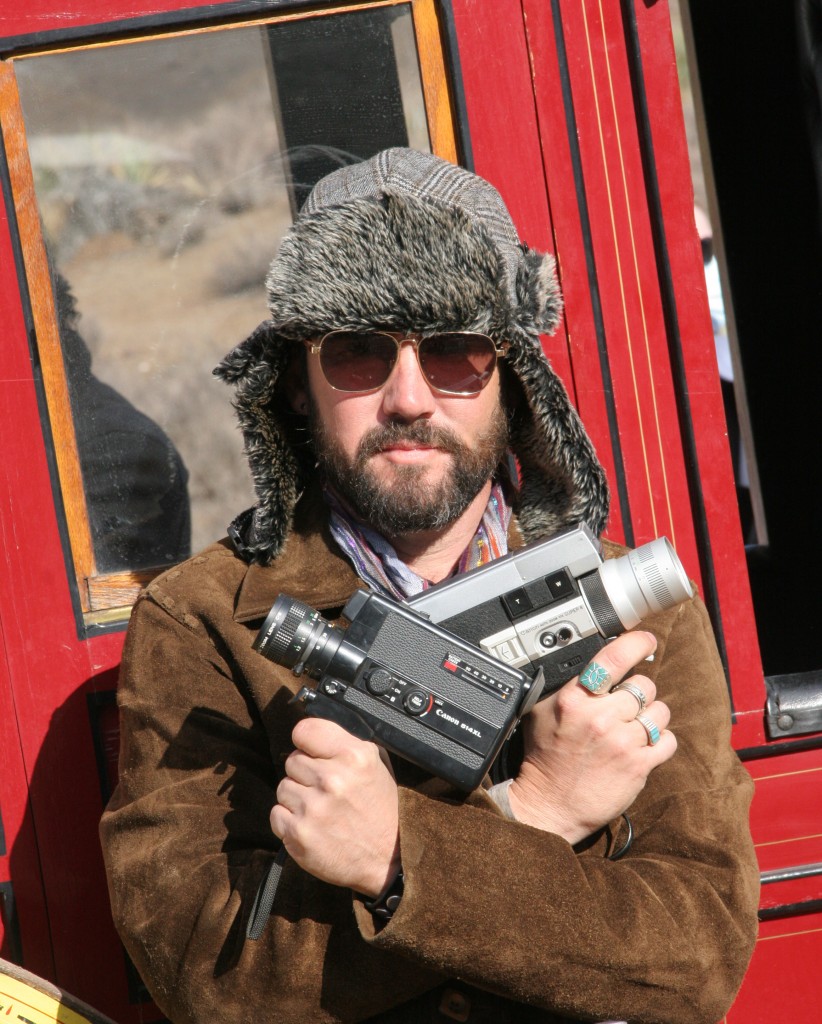 5. I noticed at the end of the film there are some outtakes filmed in the vintage Super 8 format. Did you intend to use the format for the feature? What equipment was used to film Western Religion?
5. I noticed at the end of the film there are some outtakes filmed in the vintage Super 8 format. Did you intend to use the format for the feature? What equipment was used to film Western Religion?
I shot the black and white Tri X Super 8 film throughout the production, in order to convey a sense of time travel, as if the events in the movie really happened– almost in a newsreel style. Although the Kinetoscope was not invented until 1888, about ten years after the tale of Religion, Arizona, my take on it was that it would be like tin type photos come to life. It was a lot of fun shooting on the Super 8, which was my first movie camera as a kid in the 70’s. Our main camera was the Red Epic, which produces excellent digital images. I enjoyed the dichotomy between the two cameras, between the old film camera and the new digital cinema, between modernity and the mythic past. It lent itself to the theme of Western Religion.
 6 . There was much more at stake in Religion Arizona than the results of a high-stakes poker tournament. There is an underlying supernatural theme in the film. Saint John (Gary Douglas Kohn) is the spiritual force of good while Anton Stice (Claude Duhamel) is the manifestation of evil. Western Religion has a particular take on the conflict between good and evil – one that we might not expect to see in another film. There is an ambiguity within the character’s personalities. Can you talk to us about these themes of good and evil and the supernatural that are woven into the film?
6 . There was much more at stake in Religion Arizona than the results of a high-stakes poker tournament. There is an underlying supernatural theme in the film. Saint John (Gary Douglas Kohn) is the spiritual force of good while Anton Stice (Claude Duhamel) is the manifestation of evil. Western Religion has a particular take on the conflict between good and evil – one that we might not expect to see in another film. There is an ambiguity within the character’s personalities. Can you talk to us about these themes of good and evil and the supernatural that are woven into the film?
 Many people have wondered what the significance of the title Western Religion is, beyond it being a western that takes place in the mining town of Religion. In many ways, the film is about the real religion of the West, which is Capitalism, represented in the film as the gold cross, the prize they are all playing for. And further along that theme, as they put everything on the line to win the prize, they are also putting their souls at stake. The characters must confront their own deepest desire along these ends and reckon that with what they believe in spiritually and what they think matters in the end, when all is said and done. It taps into the notion of power, both the power of separation, vis-a-vis the age old divide and conquer strategy for governing human affairs and the ultimate power and strength of unity and the cooperation that comes from a recognition of the fact that we are all one. The movie operates on the allegorical level of fable, almost like the Wizard of Oz. It’s important to take it on that level or much can be lost in viewing it from a merely surface perspective.
Many people have wondered what the significance of the title Western Religion is, beyond it being a western that takes place in the mining town of Religion. In many ways, the film is about the real religion of the West, which is Capitalism, represented in the film as the gold cross, the prize they are all playing for. And further along that theme, as they put everything on the line to win the prize, they are also putting their souls at stake. The characters must confront their own deepest desire along these ends and reckon that with what they believe in spiritually and what they think matters in the end, when all is said and done. It taps into the notion of power, both the power of separation, vis-a-vis the age old divide and conquer strategy for governing human affairs and the ultimate power and strength of unity and the cooperation that comes from a recognition of the fact that we are all one. The movie operates on the allegorical level of fable, almost like the Wizard of Oz. It’s important to take it on that level or much can be lost in viewing it from a merely surface perspective.
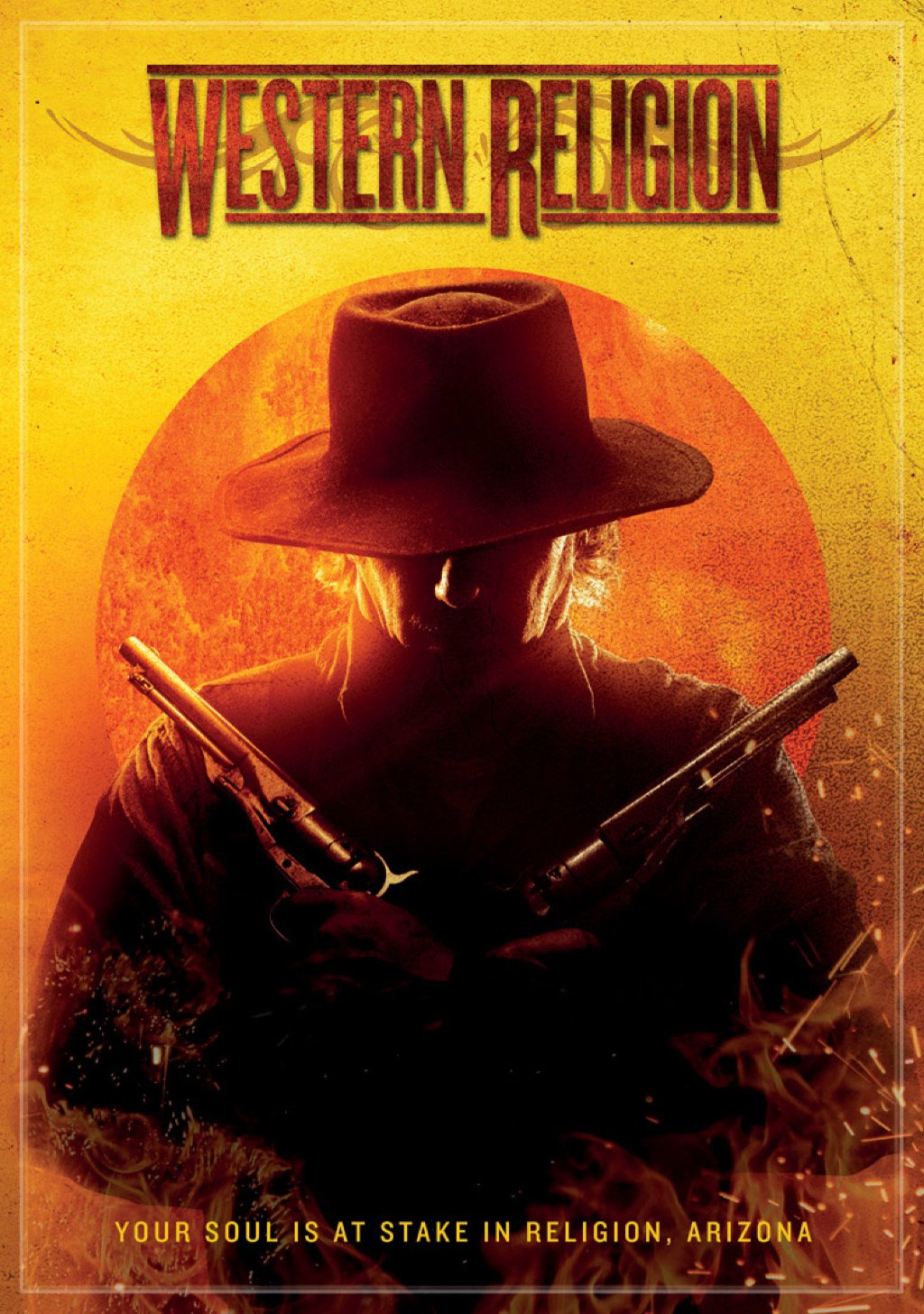 7. I noticed you used Gary Douglas Kohn’s image for the poster. I like that poster! How did you choose the design for the posters?
7. I noticed you used Gary Douglas Kohn’s image for the poster. I like that poster! How did you choose the design for the posters?
Our first two posters were designed by Casey Garza, a great poster artist who does the official poster of the American Film Market each year. The first was a poster with the gold cross, from an illustration by Adam Schadenfroh. The second was our poster for Cannes, Tears of Religion, the gun barrel stigmata poster. Casey is married to another great artist, photographer Linda Wake-Garza, who did our fantastic Last Supper photo shot. The new poster was designed by Screen Media. It features Gary Kohn as Jackeroo John, his previous incarnation prior to becoming Saint John.
8. Have you made plans to bring the film to Japan? Do you think your story from the old West will be popular to the Japanese public?
I would love to come to Japan with Western Religion, or any film for that matter. We are currently in negotiations with an international distributor. That deal will be done very soon and I trust it will bring us into the Japanese market. It has long been my desire to go there. Hopefully, there will be an audience for a film that departs a bit from mainstream Hollywood. We will find out .
9. I understand you have been working on a new production called The Backward Path. Ca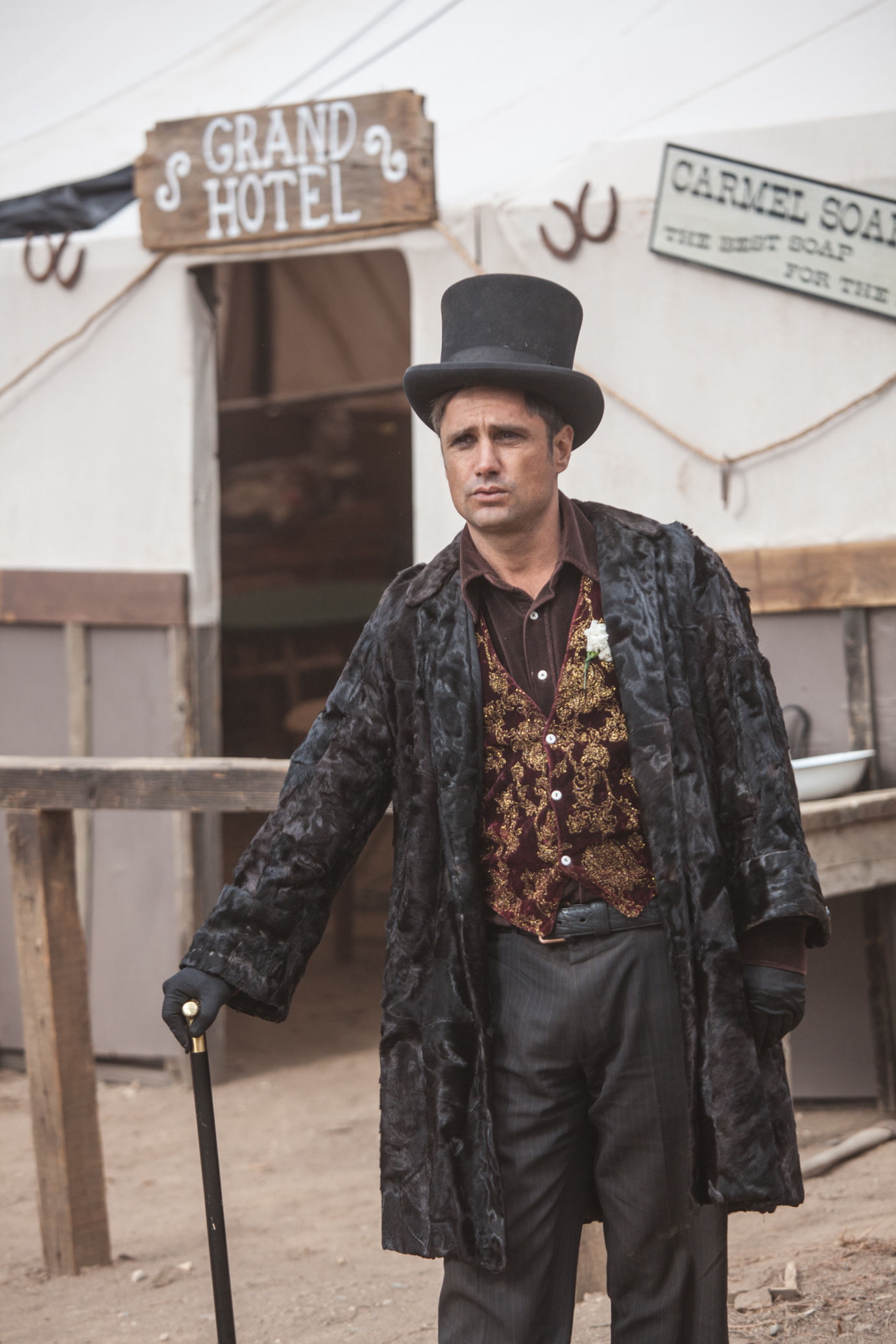 n you tell us about the film?
n you tell us about the film?
I was commissioned to write the neo-noir script The Backward Path. Producers Ron Soha and Louie Sabatasso were very happy with the script and I wish them the best with putting together their production. They have some great ideas for it.
10. What else have you been working on recently?
As far as my work goes, I’ve been hired to write a new script by a top notch UK production company. It’s along the lines of Trainspotting meets The Departed. It’s going great and I’m very excited about it. Regarding my next directorial job, it will either be a fantasy film in Virtual Reality or a traditional film in the pirate genre. Both are on the table. I’ve also been approached by a couple of commercial production companies since the tour, so I may explore something in that space, as well. I’m looking forward to the next adventure.
edited by Anthony Heller

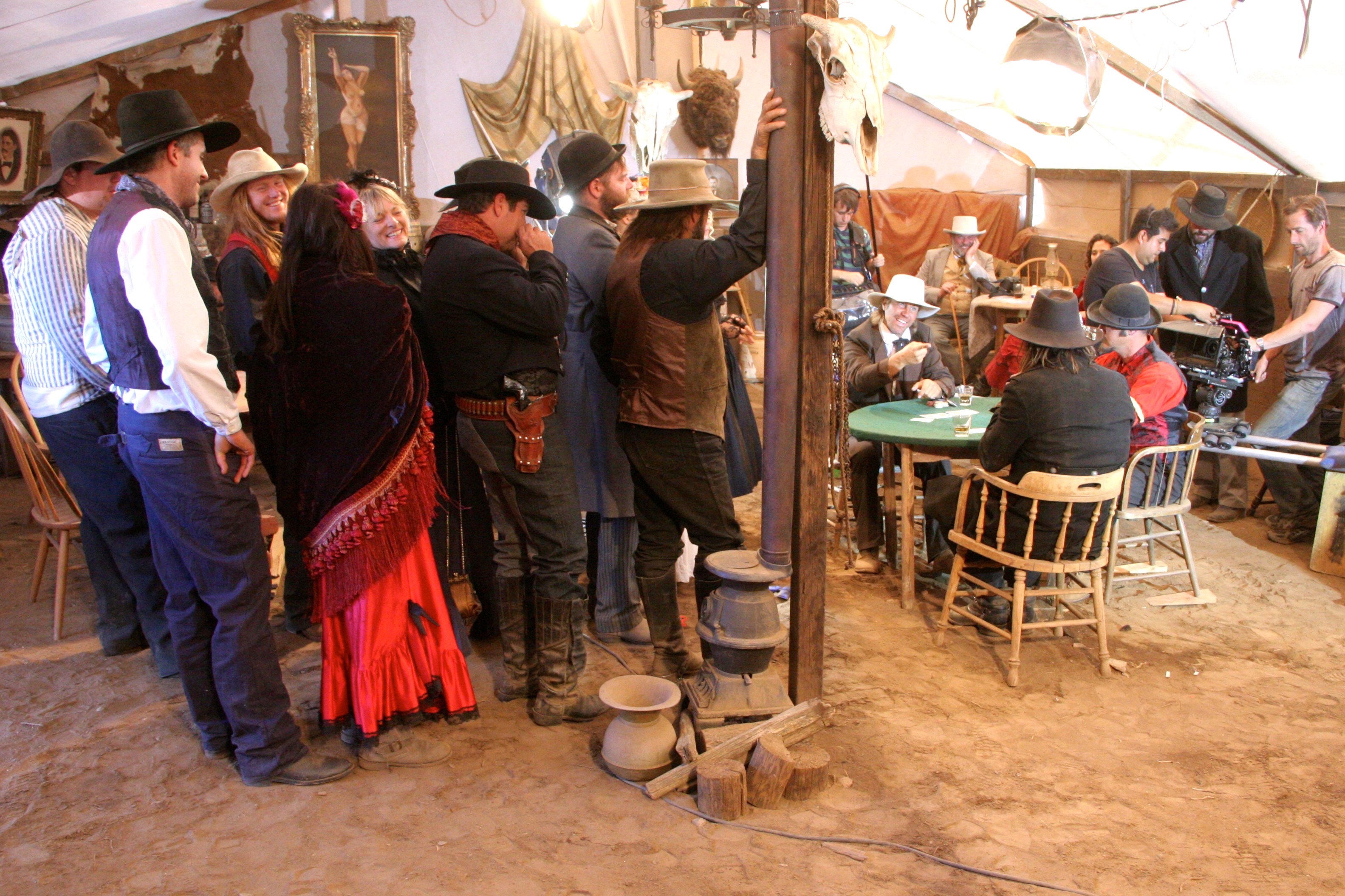




You must be logged in to post a comment Login